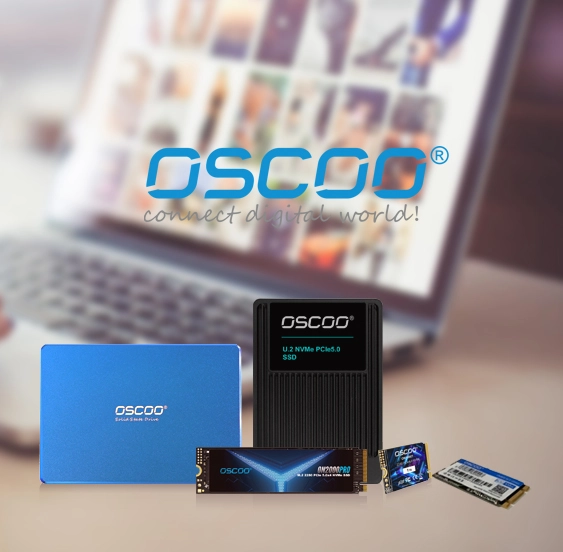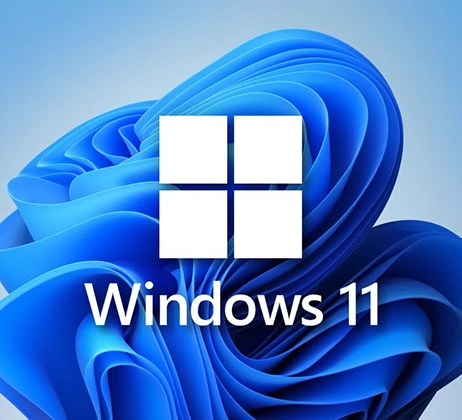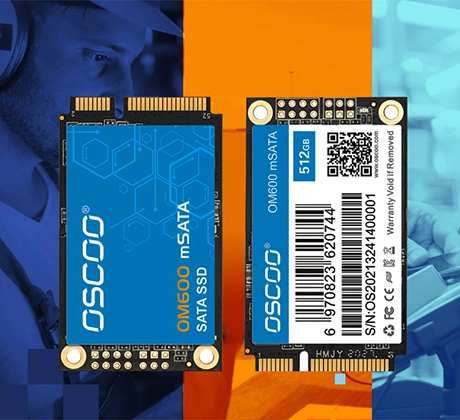
Imagine storing your entire high-definition movie library, a large game collection, or years’ worth of work files into a device smaller than your wallet, capable of reading and writing data at blazing-fast speeds. Does this sound futuristic? This is actually the real-world experience enabled by portable solid-state drives (Portable SSDs).
A portable solid-state drive, often called a portable SSD, is an external storage device that uses flash memory chips to store data. It connects to computers, smartphones, tablets, and other devices via USB interfaces, most commonly the modern USB-C standard, for data transfer. Its core advantages stem from the lack of moving parts inside. This design delivers speeds far exceeding traditional portable hard disk drives, provides exceptional shock resistance, and enables a compact, card-like form factor.
Faced with the growing need for large file storage and the limitations of traditional portable storage, portable SSDs have become powerful tools for modern digital life. They excel due to three key capabilities: ultra-fast transfer speeds, reliable durability, and lightweight portability. Let’s explore how they prove valuable across various scenarios.
Оглавление
ToggleA Mobile Vault for Massive Digital Assets

In the digital age, we constantly create and accumulate vast amounts of valuable data. RAW format photos from DSLR cameras, 4K or even 8K ultra-high-definition footage captured by drones, lossless music collections, exquisite design resource packs, or downloaded HD movies and TV series – these files often measure in gigabytes or even terabytes. The built-in storage of smartphones and computers quickly runs out of space when handling such large files.
Portable SSDs offer the perfect solution:
- Ample Capacity: Portable SSDs are available in capacities ranging from 512GB to 4TB or even larger (OSCOO MD006 PSSD provide a capacity of 4TB). Imagine a tiny device capable of holding thousands of high-resolution photos, hours of high-bitrate 4K/8K video footage, or entire collections of HD movies and large software packages. They effortlessly carry your digital asset library, eliminating storage anxiety.
- Blazing-Fast Speeds: This is the portable SSD’s strongest advantage. Leveraging high-speed USB interfaces like USB 3.2 Gen 2 or faster Thunderbolt/USB4, coupled with internal NVMe flash chips, portable SSDs transfer data several times or even dozens of times faster than traditional portable hard drives (such as OSCOO’s MD008 & MD009 reach the speed of 1100 MB/s). After a photoshoot, a photographer can quickly back up a full SD card to a portable SSD in minutes rather than tens of minutes. When editing video, the speed advantage for importing and exporting large media files significantly boosts workflow efficiency.
- Easy Portability: Their compact and lightweight design, often credit-card sized and weighing very little, combined with a sturdy, all-solid-state construction, makes them ideal travel companions. Photographers and videographers can confidently carry their precious raw footage libraries. Movie enthusiasts can carry entire video libraries in their pockets, ready to watch on different devices anytime, anywhere. Ordinary users can easily transfer or back up large collections of HD videos and photos from their phones. These valuable memories and important digital assets can now follow you securely and conveniently.
Effortlessly Expanding Laptop Storage
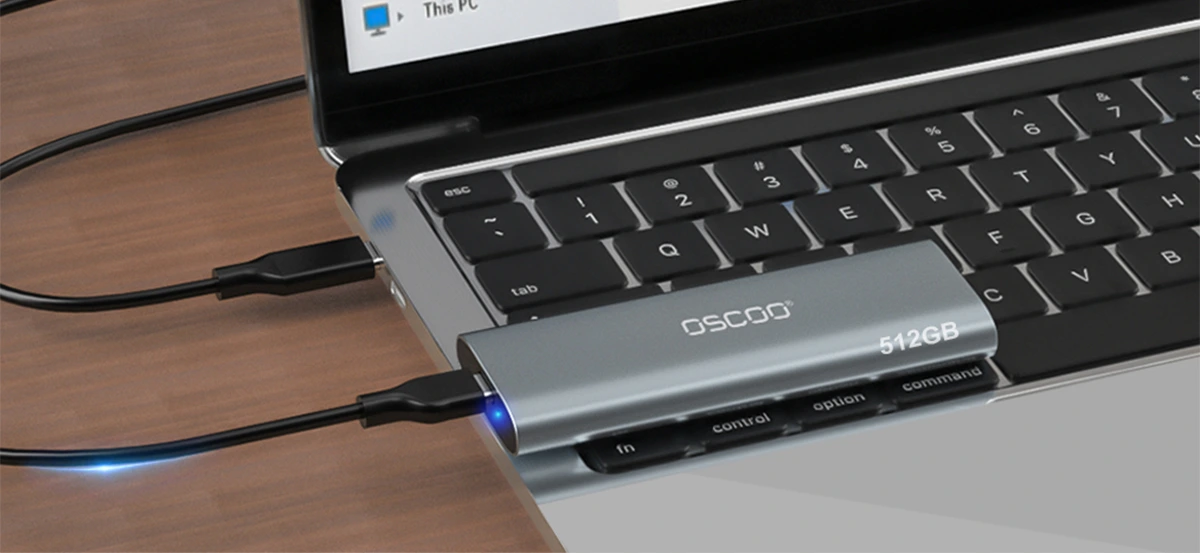
Modern laptops excel in achieving slim and lightweight designs, but this often comes at the cost of upgradable internal storage. Whether it’s the latest MacBook Air, various ultra-thin Windows laptops, or even many gaming notebooks, the built-in solid-state drive capacity, once chosen at purchase, is typically difficult or impossible to upgrade later by the user. For many, even a 512GB configuration fills up quickly after installing the operating system, essential software, a few large games, and accumulating work files, triggering storage warnings.
What to do when the internal drive is full? Opening the laptop for an upgrade carries high risks for most users and may void the warranty. Opting for a higher-capacity model directly from the manufacturer often means a significant price jump with poor value. Here, the portable SSD emerges as an incredibly flexible and efficient expansion solution.
Simply connect the portable SSD to the laptop’s USB port using a USB cable (typically Type-C to Type-C or Type-C to Type-A), especially ports supporting USB 3.0/3.1/3.2 Gen 1 or better. It instantly becomes high-speed external storage for the laptop. The operating system detects it like any other drive, requiring no complex installation. This “plug-and-play” extra space is ideal for storing large files that are rarely accessed but too valuable to delete.
Consider the files likely sitting on your computer: years of accumulated downloads, old software installer backups rarely used after installation, archived project materials, large single-player game libraries you seldom play, collected tutorial videos, or HD lossless music collections. These are prime candidates for relocation to a portable SSD. It’s inefficient for them to occupy precious internal laptop space, but storing them on a slow and shock-sensitive traditional portable hard drive makes accessing them frustratingly slow.
Portable SSDs strike a near-perfect balance. On one hand, they offer significantly larger available capacities (easily reaching 1TB, 2TB, or higher) than typical laptop internal SSDs, at a cost far lower than upgrading the laptop’s internal drive. On the other hand, thanks to their high-speed USB interfaces and internal flash technology, their transfer speeds vastly exceed those of traditional mechanical portable drives. This speed is perfectly adequate for the fast read/write needs of these archived large files. While not the optimal scenario for running the operating system or continuously operating large professional software as the primary drive, portable SSDs provide a high-speed access experience that is more than sufficient when used as dedicated large-capacity data repository drives.
Backing Up Files & Creating Emergency Recovery Drives
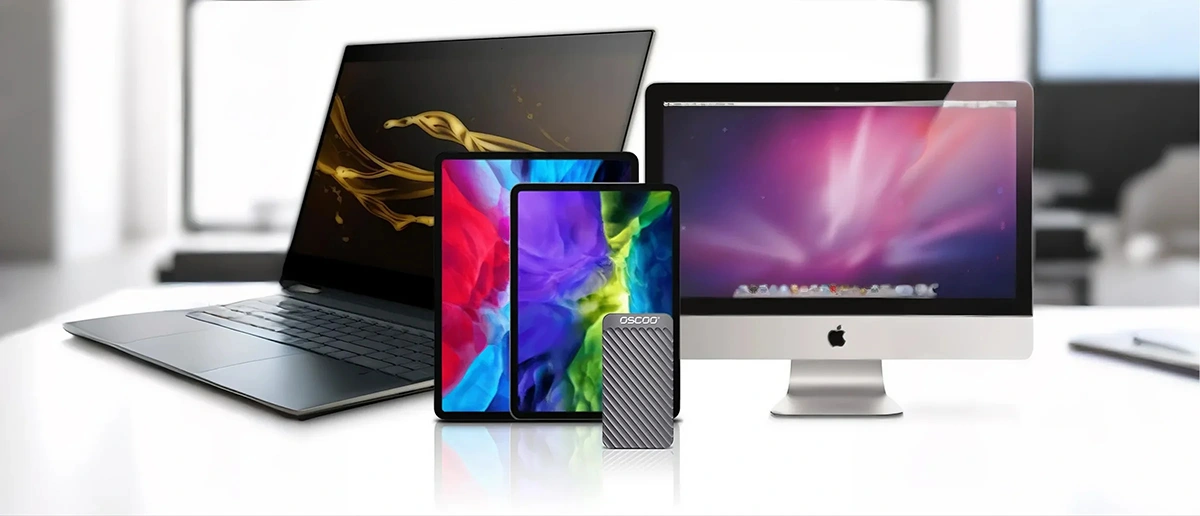
In today’s world where digital life and work are increasingly vital, our precious photos, critical documents, hard-earned project files, and even carefully configured operating systems face risks of loss. Hard drive failures, attacks by viruses or ransomware, human error, device loss, or physical damage – these accidents can happen anytime, potentially destroying effort and causing significant loss and inconvenience. Relying solely on a computer’s internal drive is like putting all your eggs in one basket. Depending only on cloud backups, while convenient, is constrained by network bandwidth speeds; restoring data can be time-consuming, and privacy concerns persist for some users.
Portable SSDs, with their speed, reliability, and portability, form the cornerstone of a robust local backup strategy, serving as both a data “safe” and a “lifesaving drive.”
First, they excel as versatile backup repositories. Users can easily configure the operating system’s built-in tools – like Windows’ “File History” or the more powerful “Backup and Restore” (System Image), or macOS’s Time Machine – to use the portable SSD as the primary target drive. Its large capacity ensures it can hold complete system backups plus all important user files. The high-speed interface delivers a transformative backup experience. Performing both the initial full backup and subsequent incremental backups, which only copy changed files, happens much faster than with traditional portable drives or most network backup solutions. This means shorter backup windows, making it easier to maintain regular backup habits.
Second, portable SSDs support off-site disaster recovery. A core principle of backup is keeping a copy physically separate from the original. The portable SSD’s small size and ruggedness make it perfect for this. After performing critical backups, you can easily take it away from your office, studio, or home and store it in another secure location. Should a hardware failure, theft, fire, or flood strike your primary location, this offline backup becomes the key to recovery.
A crucial application is the emergency recovery/installation drive. When a computer crashes, fails to boot, suffers a stubborn virus infection, or requires a complete system reinstall, a prepared portable SSD can quickly save the day. Leveraging its high write speeds, users can rapidly deploy an operating system installer, created using tools like Windows Media Creation Tool or the macOS installer, onto the portable SSD, turning it into a high-speed boot drive. You can also store powerful third-party system repair tools on it. When a computer fails, simply connect the portable SSD and boot from the USB drive. This allows you to quickly load a rescue environment to repair the system, recover data, or perform a clean OS installation. The efficiency of this process far surpasses that of standard USB flash drives or optical discs, saving users significant time and restoring normalcy faster.
It’s also worth noting that many portable SSDs include or support hardware-level encryption, such as 256-bit AES, via built-in features or companion software. This allows protection via password or fingerprint. When storing sensitive backup files on your portable SSD or taking it with you, this encryption adds a robust layer of security for your data privacy.
In essence, a portable SSD is more than just a storage container; it’s a reliable guardian for your digital assets. Combining large capacity, high speed, and portability, it makes data backup efficient and practical, enables disaster recovery strategies, and brings emergency system recovery within easy reach, comprehensively safeguarding your digital world.
A Pocket-Sized Game Library

Modern top-tier games feature increasingly stunning visuals, leading to astonishingly large file sizes. A popular AAA title can easily require over 100GB of storage, with some approaching 200GB. For gaming enthusiasts, repeatedly downloading such massive files consumes significant time and may be hampered by network bandwidth limits or data caps, hindering the desire to game anytime, anywhere. Simultaneously, even high-performance gaming laptops or handheld consoles often see their внутренний твердотельный накопитель capacities rapidly consumed by these behemoths, frequently forcing the painful choice of uninstalling older games to make space for new ones.
Portable SSDs offer gamers an extremely flexible solution, enabling them to carry their vast game libraries and play anywhere, plug-and-play. Imagine storing games you don’t play often but can’t bear to delete, along with large, installed game libraries from platforms like Steam or Epic Games, entirely on a portable SSD. This small device becomes your personal mobile “game repository.” Modern operating systems and gaming platforms provide excellent support for this setup. On Windows, clients like Steam and Epic Games Launcher allow users to easily add and manage multiple library locations. When you connect your portable SSD filled with games to a PC or Xbox console, simply point the game platform software to this new location. The platform will immediately recognize the games already on the SSD. Typically, there’s no need for lengthy reinstallation or verification; you can directly launch and play any game in the library. This experience drastically reduces the time cost of switching games between devices.
Critically, thanks to the portable SSD’s significantly higher speeds compared to traditional mechanical drives, especially models using USB 3.2 Gen 2×2 or faster interfaces, the actual gameplay experience from these external libraries is excellent. Game map load times, level transitions, and high-resolution texture streaming are extremely smooth. While performance might be slightly lower than that of a top-tier internal PCIe 4.0 NVMe SSD (such as OSCOO ON1000 PRO SSD), it’s sufficient for a smooth experience, far surpassing the stutter often encountered with SATA SSDs or regular portable hard drives. You likely won’t even notice the game is running from an external drive.
Powering Mobile Workstations
Nowadays, creative work increasingly happens outside the traditional studio, edit suite, design firm, or music studio. However, professional creative work involves massive data: a single high-resolution RAW photo can easily exceed tens or even hundreds of megabytes; 4K/8K video footage consumes gigabytes per minute; large PSD design files, 3D models, or sample libraries also demand significant space. These enormous files require not only vast storage capacity but also place near-critical demands on read/write speeds and reliability. Traditional portable hard drives often struggle with real-time preview and editing of high-resolution media, causing slowdowns that severely impact workflow efficiency. Relying on repeatedly copying data between multiple devices is time-consuming and increases the risk of versioning errors and data loss.
Portable SSDs, especially high-performance models using the NVMe protocol paired with Thunderbolt or high-speed USB 4 interfaces, have become core components for photographers, videographers, video editors, designers, animators, and music producers building mobile workstations, thanks to their extreme speed and exceptional reliability.
They function not just as static “warehouses” but as efficient “working drives.” Professionals can place entire current projects’ source media, project files, and caches directly on the portable SSD. A videographer returning from a field shoot can connect a high-speed portable SSD via Thunderbolt to their laptop, bypassing the need to slowly copy terabytes of 8K RAW footage to the internal drive first. Leveraging the SSD’s sustained read/write speeds exceeding 1000 MB/s, editing software like Adobe Premiere Pro, Final Cut Pro X, or DaVinci Resolve can smoothly preview multi-track, multi-layer, high-quality raw footage on the timeline without stuttering, enabling editing, effects addition, and rendering previews directly on the external SSD. This ability to work in real-time directly on high-speed external media dramatically boosts efficiency in mobile scenarios, breaking the previous limitation of needing to transfer files to the internal drive first.
Seamless Collaboration Between Devices is another killer application for portable SSDs. Their compact size and broad compatibility (via USB-C/Thunderbolt) make them the perfect “data containers” for moving projects between devices and collaborators. A photographer can import and cull RAW photos on a Windows desktop during the day, then take the SSD home and connect it to a MacBook Pro for color grading. This freedom to move across platforms and devices makes team collaboration and individual workflows unprecedentedly flexible and efficient.
Rugged durability is especially important in professional settings. Outdoor shoots involve unpredictable environments, and travel inevitably brings bumps. The all-solid-state design of portable SSDs, lacking moving parts, gives them far superior shock and impact resistance compared to traditional hard drives. This means precious original media gets better protection during transport, safeguarding against data disasters caused by accidental bumps.
The Smartphone Companion
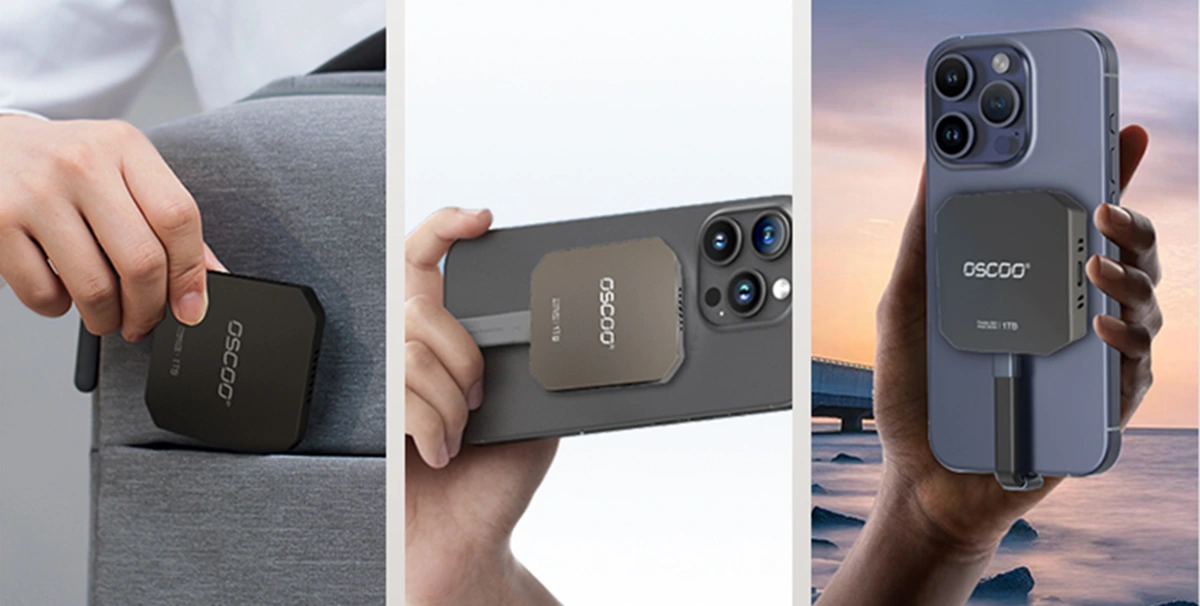
Smartphones have become our primary content creation hubs. Recording 4K and even 8K HD videos, shooting in ProRes or ProRAW formats, capturing vast numbers of high-megapixel photos – these powerful features create massive files while preserving moments. A few minutes of ProRes video can consume several gigabytes or more. Even large internal phone storage struggles under the constant “consumption” of professional creation.
While network transfers are common, they falter with huge files. Transferring tens of gigabytes of video wirelessly (Wi-Fi or Bluetooth) is slow, unstable, and can take hours or fail, often consuming significant data. Backing up via cable to a computer is the traditional method, but this requires a computer as an intermediary, adds steps, and is impossible when a computer is unavailable or inconvenient to power on.
Portable SSDs provide an efficient direct channel for transferring large files to and from smartphones. For many Android phone/tablet users, portable SSDs can directly serve as powerful external storage expansion. As long as the device supports USB On-The-Go (OTG) and has a suitable USB port, a common Type-C to Type-C or Type-C to USB-A cable enables easy connection. Once connected, the phone recognizes the portable SSD much like a USB flash drive, allowing users to directly browse, read, and write files on it. This means users can directly and quickly “move” bulky items captured or downloaded on the phone, such as long videos, large photo collections, or lossless music packs, onto the portable SSD, freeing up valuable internal space. The operation is as simple as using an oversized, high-speed flash drive.
Although iPhone/iPad users face restrictions due to iOS file system permissions, preventing direct UD-like writing to third-party devices without using Apple-approved apps or specific third-party software like iMazing, the high-speed transfer advantage remains significant for simpler tasks. iOS users can efficiently export large files like videos and photos to an SSD for safekeeping via the Files app, or import files from the SSD back into iOS devices.
Therefore, whether it’s an Android user seeking instant space relief and external storage for large files, or any user needing to efficiently move massive amounts of data between phones/tablets and computers, the portable SSD acts as a “high-speed data ferry.” It provides a physical transfer solution independent of networks, offering direct operation and astonishing speeds. This allows you to easily manage large file transfers across devices, making the portable SSD a capable companion for storage expansion and management on your mobile devices.
Conclusion
Through this exploration, we clearly see that the portable SSD has evolved from a supplementary storage option into a powerful, efficient, and indispensable mobile data hub for contemporary digital life. By perfectly blending speed, security, and portability, it makes vast amounts of data truly “always at hand, instantly accessible, and secure,” becoming an essential partner for connecting, expanding, and protecting your digital world.


